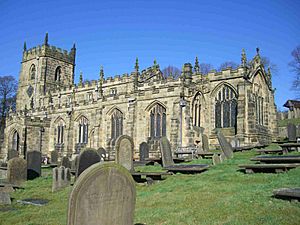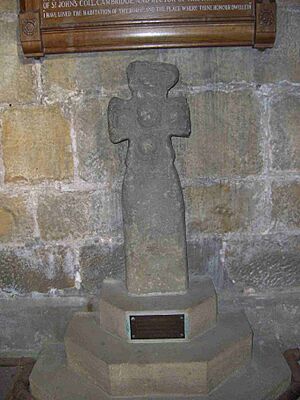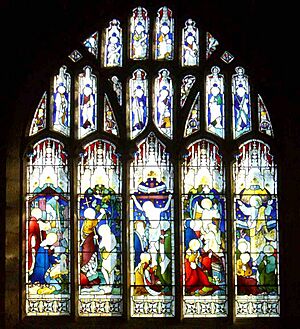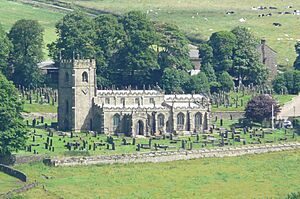Church of St Nicholas, Bradfield facts for kids
Quick facts for kids Church of St Nicholas, Bradfield |
|
|---|---|
 |
|
| 53°25′42″N 1°35′46″W / 53.42844°N 1.5961°W | |
| OS grid reference | SK 26718 92542 |
| Denomination | Church of England |
| Administration | |
| Parish | High Bradfield |
| Diocese | Diocese of Sheffield |
The Church of St. Nicholas, Bradfield is a historic church. It stands in the small village of High Bradfield. This village is about 10 kilometers (6 miles) northwest of Sheffield city centre in South Yorkshire, England. The church is very special. It is one of only five buildings in Sheffield with a Grade One listing. This means it is a very important historical building. The church sits high up, about 260 meters (850 feet) above sea level. From here, you can see amazing views of the Peak District National Park.
Contents
History of St. Nicholas Church
Early Beginnings: Anglo-Saxon Times
People have worshipped in the Bradfield area for a very long time. Christian worship here goes back to at least the 9th century. This is known because a Saxon cross was found nearby in 1870. Experts believe this cross is from that early time.
A local historian named John Wilson thought the first Norman church was built in 1109. He figured this out by reading old writing in the church's original east window. The Normans were a group who conquered England. They thought the Bradfield area was important for defending their land. They built a special fort called a motte-and-bailey nearby.
The Church of St. Nicholas was first a small church connected to a bigger one. It was linked to the Church of St. Mary, Ecclesfield, which was built earlier. St. Nicholas became its own parish in 1868.
Building Changes Over Time
The first Norman church was a simple building with two main parts. A square bell tower was added in the 14th century. Then, in the 1480s, most of the church was rebuilt. It was changed into the Gothic Perpendicular style. Builders used some of the old stone, which was local gritstone.
During the English Civil War, the church's inside changed a lot. This was because of the Puritans. They removed statues, wall paintings, and stained glass. They also painted the walls white.
Restoring the Church in the 1800s
In the late 1800s, these changes were undone. The church's inside was restored to look more like it did in the 15th century. Some parts of the original Norman church are still there today. These include parts of the north archway, the font, and the chancel arch.
The old 9th-century Saxon cross was placed in the church's north wall in 1886. This cross is made of local gritstone. It has five simple bumps on its head. This was how the Saxons showed the crucifixion.
Records of births, marriages, and deaths at the church go back to 1559. Music in the church used to be played by local musicians. They used instruments like a bassoon and a violoncello with the choir. In 1843, an organ replaced these musicians. The organ used today was put in in 1973. It was bought from a church in Middlesbrough that was closing.
St. Nicholas Church Today
Beautiful Stained Glass Windows
The church has 17 stained glass windows inside. They are all different sizes. Much of the glass is from the late 1800s. However, the Medieval Window has pieces of glass from the 15th century. During the Second World War, this window was hidden in a local clay mine. This kept it safe from bomb damage.
Some windows were designed by famous artists. These include Sir John Ninian Comper, Clayton and Bell, and Hardman & Co.. The largest window is the east window. The Wilson family gave it to the church in 1870. It shows important scenes from the life of Christ. These include his birth, baptism, crucifixion, resurrection, and ascension.
A window on the west wall was given by the Dixon family in 1930. This family owned a paper mill nearby. The main west window is in the bell tower. James Wilson Rimington-Wilson gave this window. It shows Saint Nicholas and Saint Cuthbert. This window is one of ten in the church made by William Francis Dixon. He worked for the Clayton & Bell company.
Inside the Church
The pulpit has carved pictures of Christ with the four Gospel writers. Oak panels from Normandy decorate the sanctuary and the altar. These panels were brought in 1886. The church roof is a Camber beam roof. It has carved feet and designs on its wall posts.
The original Norman baptismal font is still used. It is made of magnesian limestone and has no decoration. People believe Cistercian monks from Roche Abbey made it in the 12th century. A hidden room called a sunken vestry was found and fixed up in the 1800s. It is thought that visiting priests used this room to sleep.
Memorials and History
The church has memorials for the men from Bradfield who died in both World wars. A special slate plaque is in the south aisle. The local water authority gave it in 1989. It remembers the Great Sheffield Flood of 1864. During this flood, a nearby dam broke, and 270 people drowned. Many flood victims are buried in the churchyard. The grave of William Horsfield is also there. He was the person who found the crack in the dam. He died in 1881.
The Bell Tower and Watch House
The bell tower holds eight bells. They were made by John Taylor Bellfounders in Loughborough. Six bells were made in 1847. Two more were added recently in 1997.
Records show that Bradfield's bells were rung for special events. They were rung on November 5th to remember the Gunpowder Plot. From 1660 onwards, they were rung on May 29th. This day, called Oak Apple Day, celebrated The Restoration.
Next to the main gates is a strangely shaped building called a watch house. It was built in 1745. Its purpose was to guard against grave robbers. These robbers would dig up fresh bodies for medical study. Friends and family of the dead would often guard graves with guns. This watch house is the only one left in Yorkshire. Today, it is a private home.
In 1987, Bradfield village lost its church hall. So, some pews were removed from the back of the church. This created a meeting place and a kitchen for the community.





